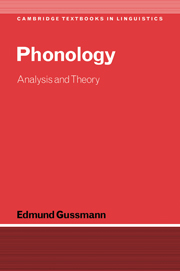Book contents
- Frontmatter
- Contents
- Preface
- List of abbreviations
- 1 Sounds and segments
- 2 The melody and the skeleton
- 3 Domains and phonological regularities
- 4 The syllable
- 5 More on codas
- 6 Some segmental regularities
- 7 Syllable structure and phonological effects: quantity in Icelandic
- 8 Segmental double agents
- 9 Words and feet: stress in Munster Irish
- Conclusion
- Appendix The phonetic alphabet of the International Phonetic Association
- References
- Index
7 - Syllable structure and phonological effects: quantity in Icelandic
Published online by Cambridge University Press: 05 June 2012
- Frontmatter
- Contents
- Preface
- List of abbreviations
- 1 Sounds and segments
- 2 The melody and the skeleton
- 3 Domains and phonological regularities
- 4 The syllable
- 5 More on codas
- 6 Some segmental regularities
- 7 Syllable structure and phonological effects: quantity in Icelandic
- 8 Segmental double agents
- 9 Words and feet: stress in Munster Irish
- Conclusion
- Appendix The phonetic alphabet of the International Phonetic Association
- References
- Index
Summary
Introduction
In the preceding chapters we have introduced a cluster of notions connected with the phonological organisation of the language. We have seen that phonological units, apart from following each other in sequences, are structured internally into the skeleton and the melody, and also externally into larger chunks such as onsets and rhymes. Various modifications such as, for example, sharing arise as a result of the interactions of such phonological units in different combinations. This chapter will be devoted to an in-depth analysis of basically one problem in the phonology of Modern Icelandic, namely vowel quantity. We will try to see what the theoretical apparatus developed so far can do to cope with the facts of the language, and also what the facts of the language can tell us about the nature of phonological regularities. Although our main concern will be vocalic length or quantity, we will also need to look at a few other phenomena that are closely connected with it. This reflects the predominant situation in phonology, where very few regularities in the language can be analysed in complete isolation from other data. Normally, phonological regularities are connected in various ways and can only be properly appreciated and formulated when studied jointly. Needless to say, we cannot go into too many details here and for this reason the regularities other than those controlling vowel quantity will be presented briefly, and only to the extent that they are relevant to the discussion.
Information
- Type
- Chapter
- Information
- PhonologyAnalysis and Theory, pp. 157 - 185Publisher: Cambridge University PressPrint publication year: 2002
